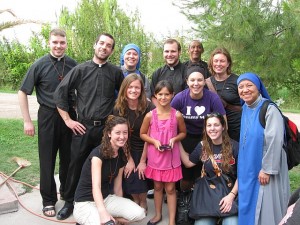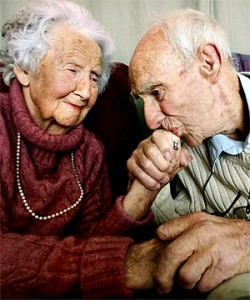Hope is one of those words (like love) that has to be rescued from a world that has overused and misused it for so long that its original meaning is almost lost. Hope has come to mean something amounting to a vague wish for something or a substitute for the word “maybe.” For example a person might say, “I hope it doesn’t rain tomorrow.” Usually what hope means here is that “I wish it wouldn’t rain,” or “It probably will rain but it sure would be nice if it didn’t.” Another example: A person is asked, “Will you be at the meeting tomorrow?” And they respond, “I hope so.” But what this expression most often means “Maybe I’ll be there.” In both examples, doubt clouds the use of the word, the desired outcome seems unlikely. It is true the word hope is not always used in rather doubtful situations but too often it merely expresses a wish whose outcome is more doubtful than likely, when things could go either way.
I cannot set forth a whole treatise on hope here but would like to set forth certain teaching to try and rescue hope from it’s secular meaning or at least distinguish the Theological Virtue of Hope from secular hope.
The Theological Virtue of Hope is Confident Expectation – And this brings us to the theological meaning of the word hope which is a much more vigorous word in its religious setting. The definition I memorized of hope back in Seminary is the older one in use prior to the current Catechism but I list it here since it captures the vigorous quality of the word:
Hope is the Theological Virtue wherein one confidently expects God’s help in attaining eternal salvation.
The Catechism of the Catholic Defines Hope in the following way :
The theological virtue by which we desire and expect from God both eternal life and the grace we need to attain it (Glossary, cf # 1817)
Notice first of all how much more vigorous hope is in these definition. It is a “confident expectation.” The Catechism in # 1817 quotes from the letter to the Hebrews which says, Let us hold fast the confession of our hope without wavering, for He who promised is faithful (Heb 10:23). This is more than a vague wish of something that is unlikely or could possibly go either way. This is more than a “maybe God will save us.” Rather it is vigorous because the One who has promised is trustworthy, true and able. It is also vigorous because true hope is a Theological Virtue. That is to say it is infused into the soul of the believer by God himself. Hence, although it interacts with our human nature and builds on it, it does not wholly depend on our mood or temperament.
The Theological Virtue of Hope has God for its proper object – St. Thomas Aquinas makes it very clear that eternal happiness with God is the proper and true object and purpose of hope: The hope of which we now speak attains God by leaning on his help….[and] the good which we ought to hope for from God properly and chiefly is the infinite good…For we should hope from Him nothing less that Himself….Therefore the proper and principle object of hope is eternal happiness (II,IIae, 17.2). Both definitions above also make this clear. With this in mind we can see that “hope” has suffered the same fate as the word “love.” Too often people say, “I Love God…..I love my wife….I love my new car.” Obviously love has lost its meaning through overuse and misuse. So to with hope. We say, “I hope in God and to be with him eternally.” And then we say, “I hope it doesn’t rain.” But theologically hope does not pertain to things like rain, the outcome of football games, or to getting a raise, etc. Hope in Theology always has God for it’s object. I have no thought that we will ever get love and hope back to their proper objects and context but mention their origin so that we can understand that when the Church and Scripture use these words they do not mean them in the flat and often vacuous way the world does.
The Theological Virtue of Hope pertains to what we do not yet fully see or possess. – Though hope is confident expectation it is not absolute fact or current possession which some of our Protestant Brethren assert when they claim a “once saved, always saved” philosophy. St. Paul writes of hope this way: For in this hope we were saved. But hope that is seen is no hope at all. Who hopes for what he already has? But if we hope for what we do not yet have, we wait for it patiently. (Rom 8:24-25) In other words, if I were to say, “I hope I find my Bible.” and I then I find it and am holding it, hope vanishes. I don’t hope for what I already have. Hope pertains only to what I currently do not yet have or fully possess. I confidently expect that I will possess it one day for God has promised it, but I do not yet have it. I am not “saved” (past tense) as some Protestants assert but am justified through the Blood of Christ and am being saved (present active participle) as long as I hold to God’s unchanging hand by his Grace. Hence, hope is confident expectation, but not possession.
This then leads us to the two primary sins against hope – As the previous point demonstrates, a careful balance is necessary. Confident expectation of God’s help is to be vigorous. But this vigorous and confident expectation must not suffer due to either excess or defect. St. Thomas as well as the Catechism of the Catholic Church distinguish two sins against hope: Despair and Presumption.
- Despair – By despair, man ceases to hope for his personal salvation from God, for help in attaining it or for the forgiveness of his sins. Despair is contrary to God’s goodness, to his justice – for the Lord is faithful to his promises – and to his mercy. (CCC # 2091) While despair may have many complicated psychological motives it ultimately concludes that God cannot or will not save me or give the graces necessary to obtain the life he offers. Despair can pertain to thinking I will not go to heaven or, more immediately, that it is not possible live the holy life to which God summons us. Our modern world considers things like chastity, forgiveness, self control etc. to be unrealistic if not practically impossible. This is a form of despair because it denies that God’s grace can equip, empower and enable people to live holy lives. But hope confidently expects from God the graces necessary to attain to eternal life. Hence this type of despair is a sin against hope. In final despair a person rejects the gift of confident expectation of God’s help by denying that God is willing or able to save them. Thus he or she sins against hope. St. Thomas in the Summa also links despair to the captial sins of lust and sloth. The object of hope is a good that is possible by God’s grace but arduous to some extent. Now if bodily pleasures and preoccupations cause one to have a distaste for spiritual goods and thus cause a person to reject spiritual goods as “not worth the effort” then he ceases to hope for them through lust. On the other hand there are some who, seeing that something is possible but arduous, grow sad and downcast and come to see it as impossible due to this sadness or aversion to significant change required. Thus they despair through sloth (cf II IIae 20.4).
- Presumption – There are two kinds of presumption. Either man presumes upon his own capacities, (hoping to be able to save himself without help from on high), or he presumes upon God’s almighty power or his mercy (hoping to obtain his forgiveness without conversion and glory without merit) (CCC # 2092) Among many in the house of faith (both Protestant and Catholic) the second form of presumption is quite evident. We have talked at great length in this blog about the standing presumption by many if not most that just about every one goes to heaven. At too many funerals bold canonizations take place. Confident expectation of God’s help is essential to hope but presumption sins against hope by in effect claiming to already have “in the bag” what God offers on condition. We must freely accept his transformative grace and by it attain to the holiness without which no one will see God (Heb 12:14). This requires a profound work of God to take place in us. It is freely and unconditionally offered but it must be fully accept by us. Our acceptance will lead to changes that many resist and God will not force. Presumption rejects the arduous nature of what we hope for and claims to already “have” what is offered. In this way presumption sins against hope for once one has what they hope for, hope ceases. Although they DO NOT have it, by claiming they DO have it, hope dies in them, for who hopes for what he already has? (Rom 8:24). Clearly balance is required! Confidence yes, current possession or possession without condition, no. One of the best Scriptures against presumption is from Sirach:
Rely not on your strength in following the desires of your heart. Say not: “Who can prevail against me?” for the LORD will exact the punishment. Say not: “I have sinned, yet what has befallen me?” for the LORD bides his time. Of forgiveness be not overconfident, adding sin upon sin. Say not: “Great is his mercy; my many sins he will forgive.” For mercy and anger alike are with him; upon the wicked alights his wrath. Delay not your conversion to the LORD, put it not off from day to day; For suddenly his wrath flames forth; at the time of vengeance, you will be destroyed. Rely not upon deceitful wealth, for it will be no help on the day of wrath. Sirach 5:1-10
An Act of Hope:
O my God,
relying on Your almighty power
and infinite mercy and promises,
I hope to obtain
pardon for my sins,
the help of Your grace,
and life everlasting,
through the merits of Jesus Christ,
my Lord and Redeemer. Amen.



